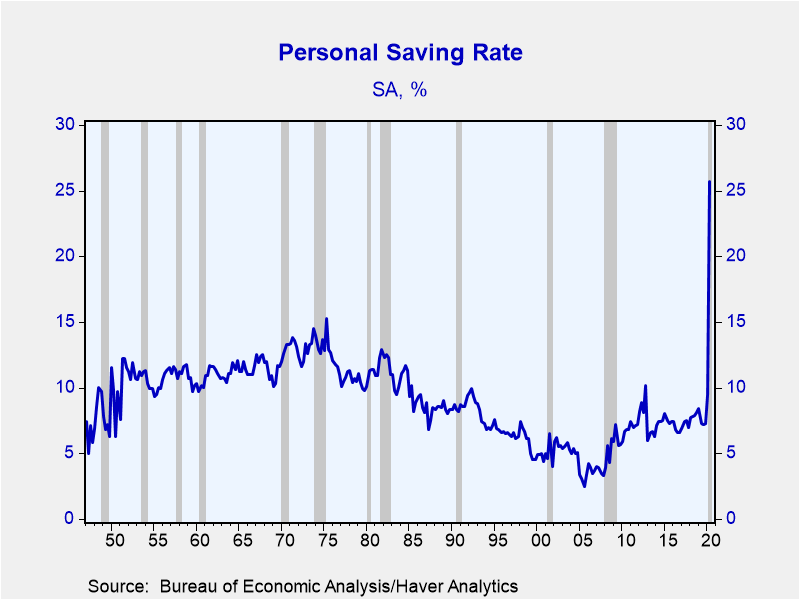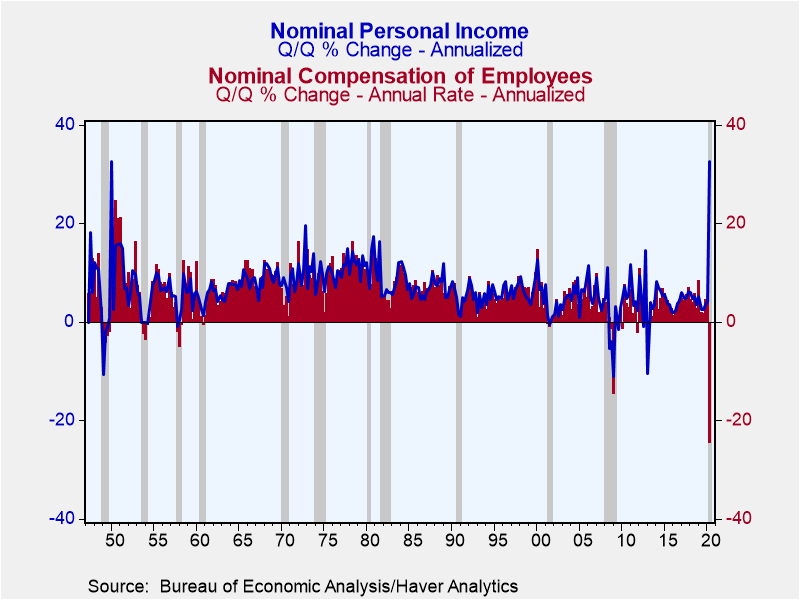 Global| Aug 03 2020
Global| Aug 03 2020Second Quarter Government Transfer Payments Likely Took the Edge Off Covid-19
|in:Viewpoints
Summary
Back when I was employed at the Chicago Fed, some of us from the economic research department and the legal department would gather in the cafeteria for afternoon coffee (not to mention morning coffee and lunch). I remember one [...]
Back when I was employed at the Chicago Fed, some of us from the economic research department and the legal department would gather in the cafeteria for afternoon coffee (not to mention morning coffee and lunch). I remember one discussion we had was whether a large insurance payout could compensate the beneficiary for the loss of a loved one. Interestingly enough, it was one of the lawyers who commented that it might not fully compensate the grieving beneficiary, but it would likely take the edge off the grief. Well, the same might be said for the Covid-related government transfer payments made to U.S. households in this past second quarter. As you will see, these transfer payments were generous. They may not have fully compensated households for the loss of loved ones and friends due to COVID-19, but they probably took the edge off their losses.
Nominal personal income grew at an annualized rate of 32.6% in the second quarter of 2020, a record high growth rate since the inception of the series back in the first quarter of 1947. Yet, nominal employee compensation contracted at an annualized rate of 24.6% in the second quarter, a record contraction (see Chart 1). How could personal income grow so rapidly when employee compensation contracted so much? The answer is government income transfers to households such as regular unemployment insurance benefits, "bonus" $600 per week unemployment benefit payments and one-time "gifts" of $1,200 per household adults/$500 per household children up to certain income levels. Chart 2 shows quarter-to-quarter annualized growth in nominal personal income and nominal personal income less personal current government transfer receipts from unemployment insurance and "other" special programs. When these government income transfers are excluded, annualized growth in nominal personal income contracted by 19.1% in Q2:2020 rather than growing by 32.6% when these government income transfers are included.
 Since 2017, the highest quarterly annualized growth in nominal personal income occurred in Q4:2017 at 6.5%. The median quarter-to-quarter growth in nominal personal income from 2017 through Q2:2020 was 4.9%. From the perspective of household finances, it would appear that U.S. households in the aggregate were generously compensated for their losses of wage income related to COVID-19, at least through the second quarter of this year. So generously compensated that the personal saving rate in the second quarter reached 25.7% -- its highest level since the inception of the series in 1947 (see Chart 3). This saving rate does not tell us in what form households saved. Stocks and bonds? Dwellings? Bank deposits, currency, coin? Probably a lot in coin inasmuch as retailers are reporting a shortage of it! We'll have to wait until the Fed releases its Financial Accounts of the United States report (formerly known as the flow-of-funds report) for the second quarter on September 21st.
Since 2017, the highest quarterly annualized growth in nominal personal income occurred in Q4:2017 at 6.5%. The median quarter-to-quarter growth in nominal personal income from 2017 through Q2:2020 was 4.9%. From the perspective of household finances, it would appear that U.S. households in the aggregate were generously compensated for their losses of wage income related to COVID-19, at least through the second quarter of this year. So generously compensated that the personal saving rate in the second quarter reached 25.7% -- its highest level since the inception of the series in 1947 (see Chart 3). This saving rate does not tell us in what form households saved. Stocks and bonds? Dwellings? Bank deposits, currency, coin? Probably a lot in coin inasmuch as retailers are reporting a shortage of it! We'll have to wait until the Fed releases its Financial Accounts of the United States report (formerly known as the flow-of-funds report) for the second quarter on September 21st.
I want to emphasize that the COVID-related government transfer payments were generous in the aggregate. Whether they were distributionally (if that's a word) generous, is another question. For example, why should adults and children have received $1,200 and $500, respectively? If the adults had become unemployed because of COVID-19 and were entitled to unemployment insurance benefits plus the $600 bonus, why were they entitled to $1,200 "gift"? What's more, if the adults were still employed, why were they entitled to $1,200 "gift"? And a $500 gift for each kid? Perhaps to buy them IPads to keep them occupied while Daddy was on a Zoom call? As a compassionate member of society, I have no qualms about having my current or future taxes go up to replace income lost by my fellow society members because of COVID-19. But why should personal income have grown at a record annualized pace of 32.6% due in large part to government transfer payments in the second quarter when the median annualized quarterly growth had been running at 4.9% in recent years? We are going to pay for this government "generosity" in one way or another in the future. The payment will be in the form of higher tax rates, reduced government spending and/or higher inflation. There is no such thing as a free government transfer program.
Viewpoint commentaries are the opinions of the author and do not reflect the views of Haver Analytics.Paul L. Kasriel
AuthorMore in Author Profile »Mr. Kasriel is founder of Econtrarian, LLC, an economic-analysis consulting firm. Paul’s economic commentaries can be read on his blog, The Econtrarian. After 25 years of employment at The Northern Trust Company of Chicago, Paul retired from the chief economist position at the end of April 2012. Prior to joining The Northern Trust Company in August 1986, Paul was on the official staff of the Federal Reserve Bank of Chicago in the economic research department. Paul is a recipient of the annual Lawrence R. Klein award for the most accurate economic forecast over a four-year period among the approximately 50 participants in the Blue Chip Economic Indicators forecast survey. In January 2009, both The Wall Street Journal and Forbes cited Paul as one of the few economists who identified early on the formation of the housing bubble and the economic and financial market havoc that would ensue after the bubble inevitably burst. Under Paul’s leadership, The Northern Trust’s economic website was ranked in the top ten “most interesting” by The Wall Street Journal. Paul is the co-author of a book entitled Seven Indicators That Move Markets (McGraw-Hill, 2002). Paul resides on the beautiful peninsula of Door County, Wisconsin where he sails his salty 1967 Pearson Commander 26, sings in a community choir and struggles to learn how to play the bass guitar (actually the bass ukulele). Paul can be contacted by email at econtrarian@gmail.com or by telephone at 1-920-559-0375.




